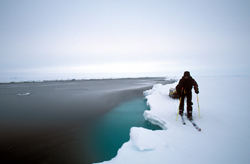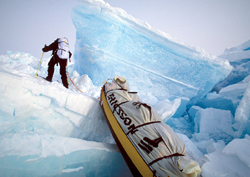The Arctic Ocean
The Arctic is one of the world's seven seas. Its top is frozen and the floating ice is around 16 million sq. km, (greater than the US), shrinking in summer to 9 million sq. km. As the ice shrinks, open water leads expose the black water.

The Arctic Ocean is the most humid place on earth, wetter even than the Amazon rain forest. The humid, cold sheet of floating ice is home to seals, polar bears and arctic fox.
The waters are warmer than the air and the ice is saline. The Polar cold is caused by the earth's incline away from the sun, with the ice further reflecting away 80% of the sunrays reaching there. Although the Arctic (min temp -68C) is warmer than Antarctica (min temp -89.2C), it feels colder and is colder in the beginning of a polar expedition. The sun stands low on the horizon through April, causing temperatures of -40-50C and a dusky light. The humidity adds to the cold. Later in season instead, a dense fog rises from the exposed sea and envelopes the ice.
The ice breaks up in open water leads. The leads are not deep, but the ocean in them is. If you fall into a lead, up to 4000 meters of dark, cold water will suck you down.
The main obstacles to an Arctic crossing expedition are moving ice floes, negative ocean drift, pressure ridges and open water leads. Two major circulation patterns for Arctic sea ice are present: the Transpolar Drift and the Beaufort Gyre. The Transpolar drift carries ice westward from the Russian Arctic, the Beaufort Gyre is located north of the Alaskan and Canadian coast, and it rotates in a clockwise motion, exiting in the Farm Strait. At some points this ice migration will carry the expedition backwards and away from the pole.
Antarctica's ice shield is thick down to 3000 meters; the Arctic sea ice is 5 meters/17 ft at the most. This is the old ice, which has survived two or more summer seasons. At the end of the winter, most of the ice is only around 2 meters/6 ft, down to an inch thin. The ocean movement breaks up the thin ice and piles it up. At places of particular ice disturbance, there will be the equivalent of a demolished building site to be crossed mile after mile, in addition to ice ridges up to 5 m/15 ft tall.
On certain occasions; storms, in the late spring and during a full moon - the Arctic ice brakes up with peculiar sounds building up to terrifying alarm. Thin sea ice moves up and down with wave action as you walk on it. "Full moon inferno," is an event caused by the tidal changes brought on by the full moon. As the ocean rises, the ice breaks up and the ice floes collide with a tremendous force.

The Arctic Ocean lacks the fabled history and beauty of Antarctica. It is instead a place for the most brutal and exposing adventure on earth.